The cinematic broadcasts (most live and some delayed) from the world’s leading theatres, especially from the Royal Opera House in London, the Metropolitan Opera in New York, and the Paris Opera, have become a true institution over recent years.
Several cinema chains also offer a subscription for a full season, much like theatres do. One can only welcome this development as it achieves numerous objectives, including allowing some music lovers who cannot afford to travel to access major lyrical events locally and possibly to popularise opera among those who might not always dare to step into theatres that schedule this repertoire, considering it to be somewhat of an “esoteric” world, and finally, to satisfy fans who, although regular opera-goers, wish to experience a greater number of performances, especially since in some regions, unfortunately, these are decreasing, most often due to budgetary constraints.
Cinema also has other virtues: that of perfect visibility and the use of close-ups that highlight the interpretation of certain artists who have now become true actors due to the evolution of the lyrical art over more than half a century through the emergence of eminent theatre or cinema directors, consequently giving rise to a new generation of “singer-actors”. Today, one obviously still goes to the opera to hear voices and music – undeniably powerful vectors of emotion – but also to be transported by an interpretation – in the full sense of the term – in a century where theatre as well as cinema are the effective mirrors of a truth based on life itself. The “real” has supplanted the “artificial”.
From this perspective, and to illustrate our point, the choice of Madama Butterfly is not trivial.
We were able to see this work on stage successively at the Verona Arena in September 2023, then at the Nice Opera and the Anthéa Theatre Antibes in March 2024. The cinematic broadcast of the Royal Opera House production in London provides an exciting means to immerse oneself anew – through confrontation with a stage performance – in the work of Giacomo Puccini, arguably one of the most popular in the lyrical repertoire (and as we recently wrote: “the darling child” of the composer).
Furthermore, the role of Madam Butterfly (or more accurately, that of Cio-Cio-San, the protagonist’s exact name) is distinguished by her constant presence on stage from the fifteenth minute of the piece.
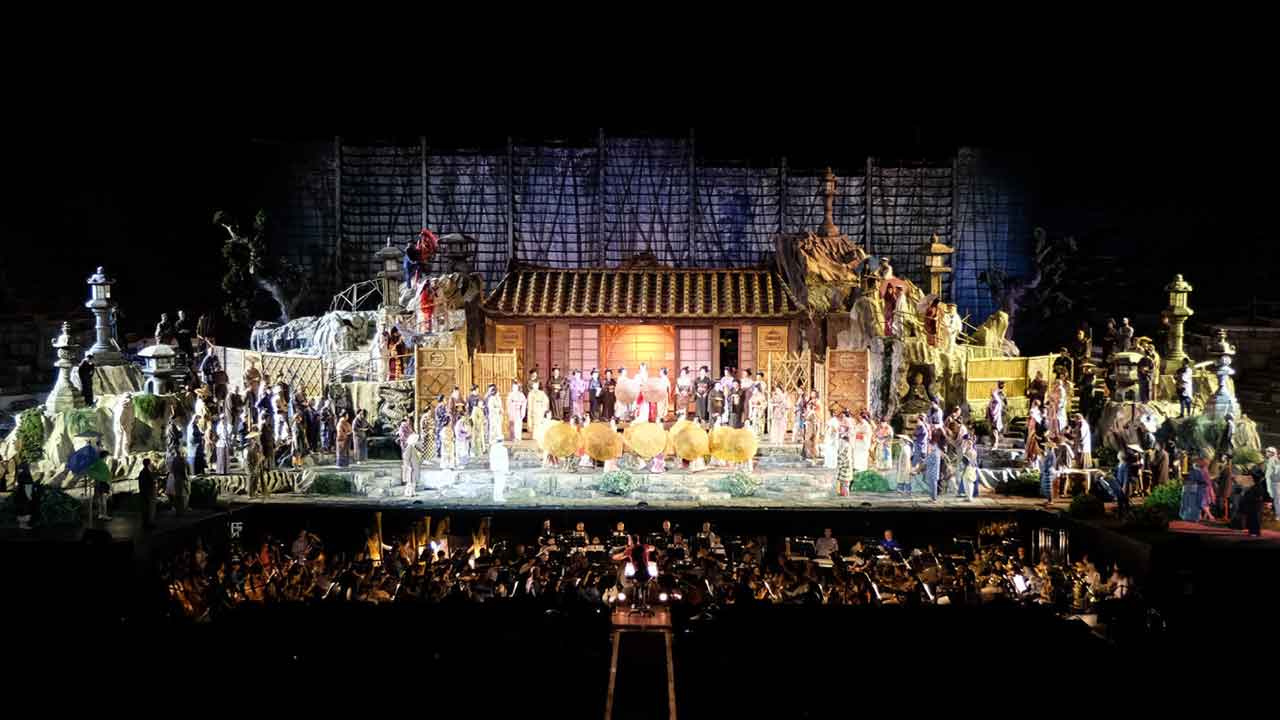
Moreover, this choice becomes all the more compelling when considering the main performer, namely Asmik Grigorian. It proves most intriguing to compare the performance of the Lithuanian soprano first in one of the largest open-air venues (that of the Verona Arena, seating over 20,000) and then, in a theatre setting (at the Royal Opera House) through a broadcast on the big screen. Neither the conditions nor the perceptions can be identical between an arena and an “enclosed” performance space, which will surely remain the favoured venue for a multitude of reasons that seem unnecessary to elaborate here, as it can only convince lovers of lyrical art. Cinema introduces a third path.
And yet… seated in our chair in front of the big screen, we could not miss a few sobs – barely held back – heard in the rows nearby, proving that opera, regardless of the ways it is listened to and the approaches to it, reveals itself as the extraordinary emotional vehicle we mentioned above.

Asmik Grigorian’s Cio-Cio-San is indeed simply exceptional (are there other terms when the words we might use seem trite?). In Verona (in the year 2023, marking the centenary of this institution), the lush and lavish (perhaps overly so?) stage design by Franco Zeffirelli, adapted to the immense space of the Arena, reconstructs an entire district of Nagasaki at the foot of a colossal hill, into which Cio-Cio-San’s dwelling, more resembling a palace than the humble cottage described in the libretto, is almost embedded. In this place, a multitude of extras, tourists, sailors on leave, locals, passers-by, enticing young women, itinerant musicians, servants, carriers, shopkeepers, and servants etc., come and go. The story of the poor geisha is somewhat smothered by this abundance of detail!
And yet, perhaps through her voice and interpretative genius (although framed by the constraints of a staging whose classicism cannot be disrupted), Asmik Grigorian had given a particularly moving performance of the young Japanese adolescent who ultimately sacrifices herself in despair of love. But how can one perceive the multitude of expressions in her gestures and even more so on her face when seated on a tier at distances that do not allow such perception?
Be that as it may, this appointment will remain memorable, and we will keep in our memory a detail that remains characteristic of such an evening. When Asmik Grigorian left the Arena, walking along the vast Piazza Bra where a multitude of restaurants are situated in a semicircle, customers stood up as she passed by to give her an ovation. Such an event is obviously not seen every day, even in the memory of a dedicated opera art enthusiast!…
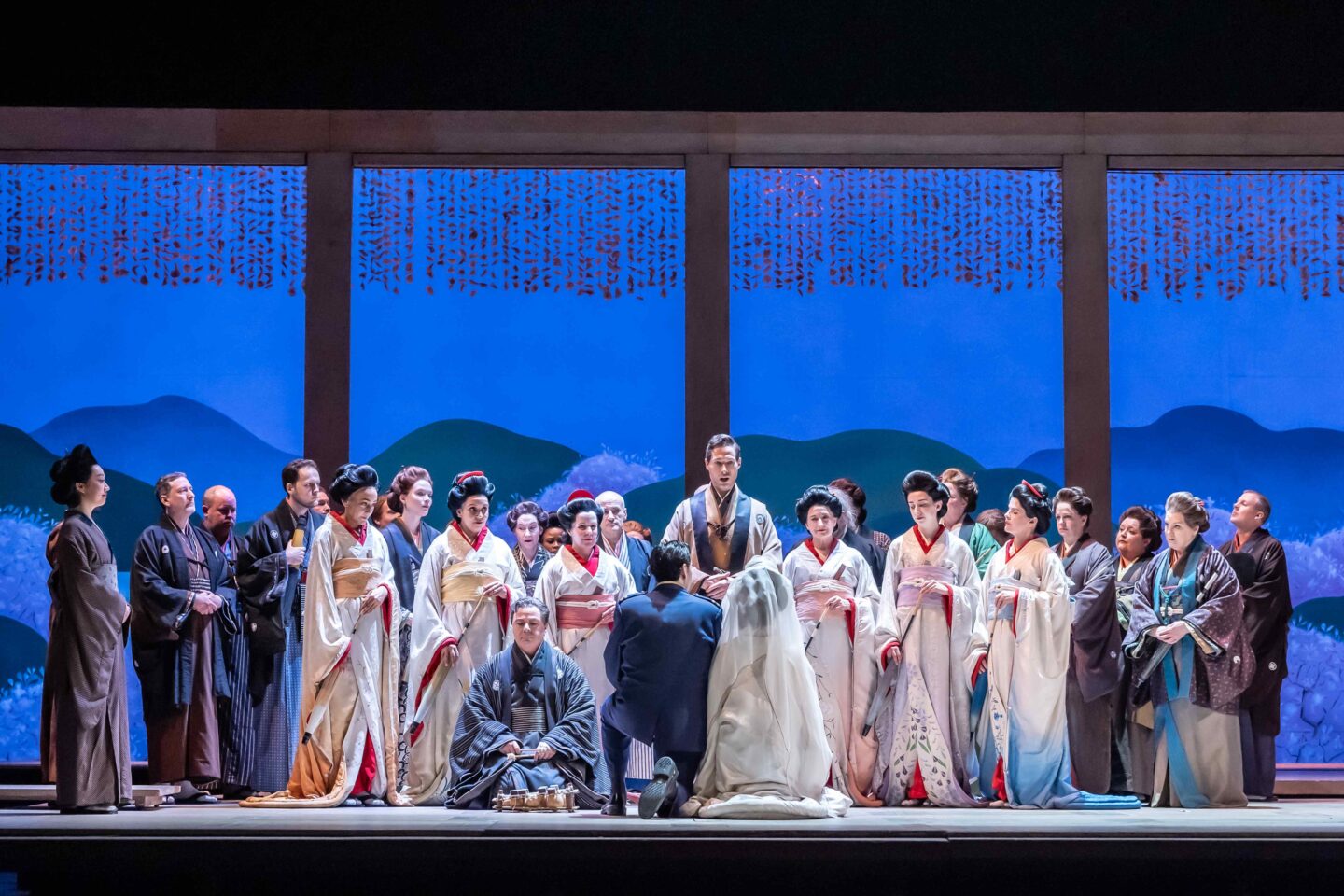
Cinema, therefore, offers a wholly different vision, and although the staging by Moshe Leiser and Patrice Caurier, well-known for over two decades and numerous editions at the Royal Opera House in London, has been broadcast via television, there remains a genuine pleasure in viewing it on the big screen, which better captures the dimensions of a stage than the small “portholes” of our homes.
But, more importantly – as we highlighted in the introduction – it allows one to catch every subtle expression on the protagonists’ faces.
The directors chose a relatively sober set design based on Japanese prints, and the entire action takes place inside Butterfly’s house, which is entirely comprised of panels that rise and fall according to the action and allow, intermittently, a view of either Nagasaki bay or the blooming trees in the garden (this is totally opposite, for example, to the production at the Verona Arena or the more recent one at the Nice Opera or many other productions that favor outdoor settings). This set design by Christian Fenouillat emphasizes Cio-Cio-San’s confinement within her four walls and justifies, if need be, the heroine’s feverish waiting for Pinkerton’s return.
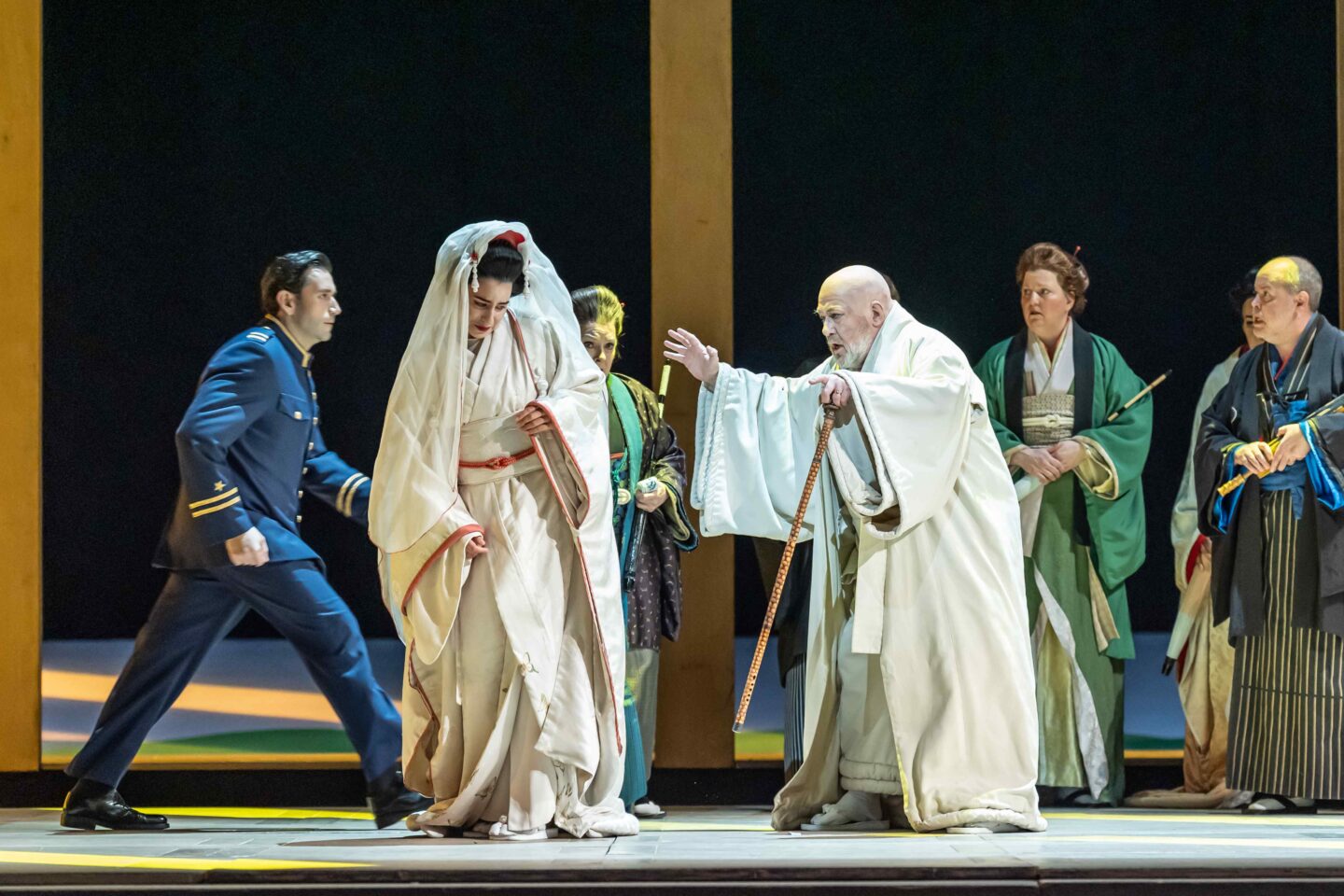
The unity of place here gives Puccini’s opera a particularly theatrical aspect, akin to a tragedy. Within the enclosed walls of a single room, Cio-Cio-San marries Pinkerton, spends a night of love with him, then, despite her poverty, raises their child, alternates between hope and disappointment over his return, and finally commits suicide there, which focuses the audience’s attention primarily on the performers’ acting. This confined setting showcases the protagonists similarly to the focus of a cinema camera, lingering on close-ups.
All in all, and knowing her impressive interpretative range, such a set design ideally suits Asmik Grigorian, who continues throughout her brilliant career to tackle roles as varied as those of Rusalka, Salome, Chrysothemis (in Elektra), Senta in The Flying Dutchman, Lisa in The Queen of Spades, Tatiana in Eugene Onegin, Turandot, and of course, the three roles in Puccini’s Trittico (Lauretta in Gianni Schicchi, Giorgetta in Il Tabarro, and Suor Angelica), etc. Her portrayal of the young geisha remains from start to finish naturally and exemplarily restrained, devoid of any “folkloric mannerism”. Where other singers might strain to accentuate, for reasons (mistakenly) of (supposed) credibility, the gestures and manners of Japanese women, this singer manages with astonishing naturalness to convey the universal – not fragmentary – character of a woman in love, betrayed, then driven to the act of supreme sacrifice in a moving sequence. Through her admirable simplicity in acting, she makes the character all the more fascinating. In fact, this Cio-Cio-San has neither age nor nationality: she is femininity itself, taken to its extreme.
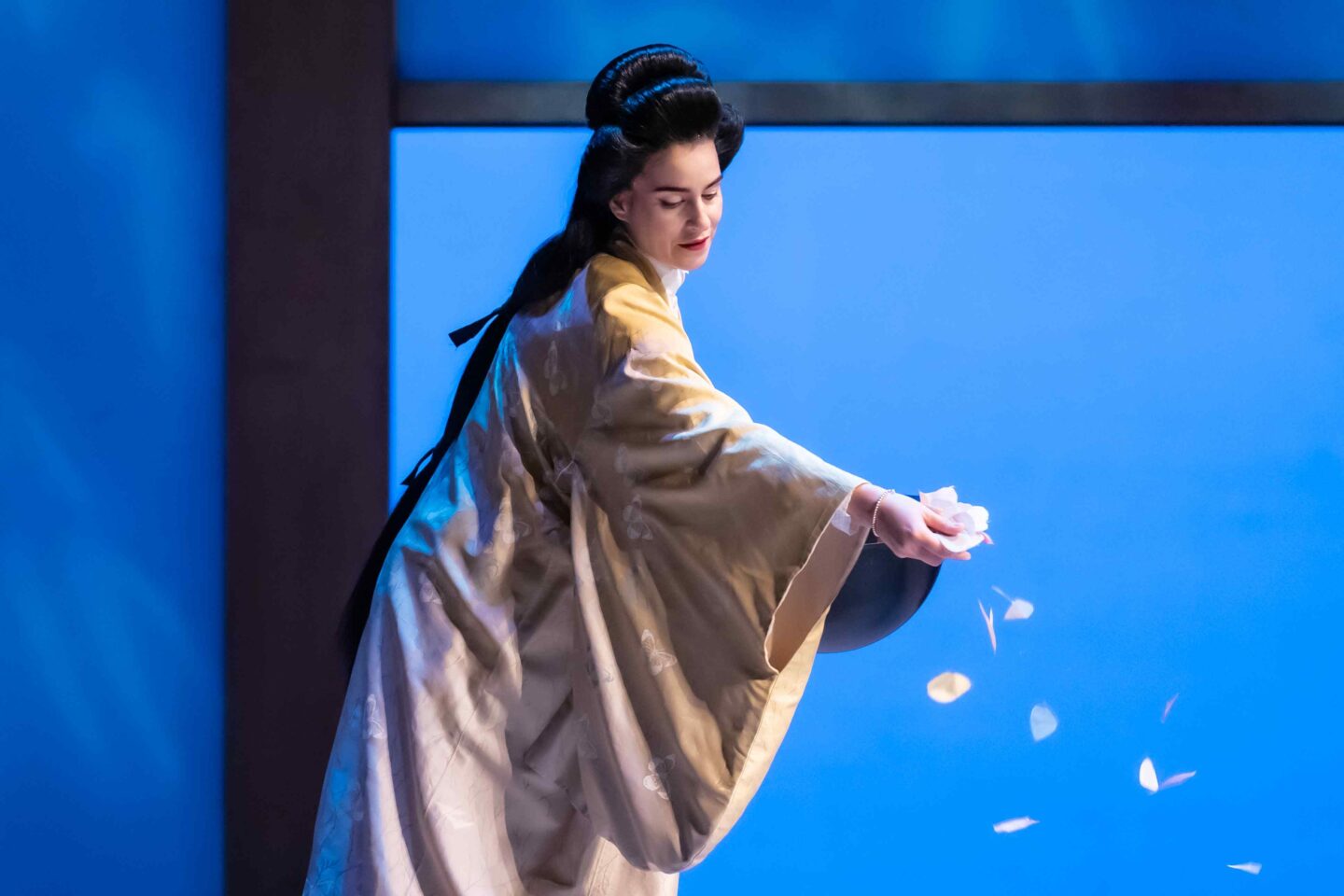
Furthermore, in this filmed version, we found the vocal qualities that are heard either in concert (during her Tchaikovsky and Rachmaninov recital at the Aix-en-Provence Festival) or in lyrical works (like Puccini’s Trittico and Macbeth at the Salzburg Festival): supreme technique, emission of pure clarity, impeccable homogeneity of the line, superbly pure and nuanced timbre, intoxicating lyricism, inexhaustible breath, powerful high notes, solid mid-range, and beautifully deep low notes. Added to this is a range of tessitura of absolute homogeneity from forte to pianissimi, with, moreover, the incredible flexibility of a masterfully controlled legato. It should be emphasized that her accomplished art of expression, which only the most eminent lyrical tragediennes possess, thus manages to evoke deep emotion, and this, with an incredible economy of means. Here is a singer who reaches heights through miraculous introspection, wielding a sublime art of phrasing and a unique sense of each word. It’s difficult to describe with adequate terms her incredible crescendos and the lyricism she unfolds, as they are beyond common language.
Alongside this anthological Cio-Cio-San is a cast of undeniable value where each of the artists proves perfectly convincing, which seems essential given the prodigious talents of the heroine.
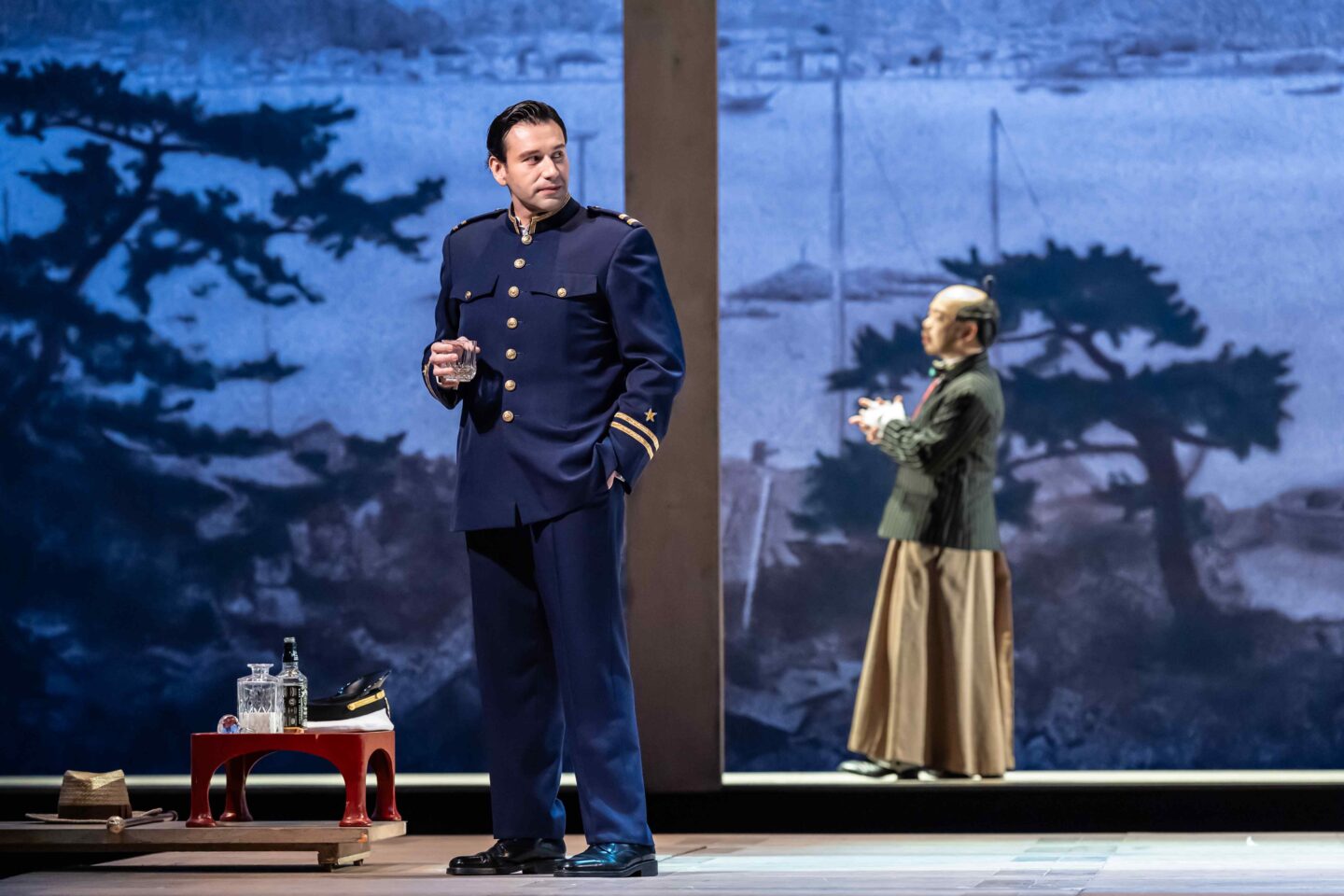
Joshua Guerrero (Asmik Grigorian’s partner in Il Tabarro from Puccini’s Trittico at Salzburg) avoids embodying the monolithic Pinkerton that is usually presented to us, driven solely by sexual attraction to the teenager, only expressing late and futile regrets in the final act. Here, a much more ambiguous character emerges, divided in his feelings, with even a hint of doubt and fragility. Vocally, we hear a rich lyric tenor voice with capabilities sometimes almost too grand for the role’s writing. At times, one is reminded of Del Monaco or Corelli. Nevertheless, the performer pays attention to certain welcome nuances.

Lauri Vasar’s Sharpless displays a theatrical and vocal elegance that makes this consul, always concerned with drawing Pinkerton’s attention to the true feelings of Cio-Cio-San, endearing.
In this production, the performers of the Japanese roles are all Asians, which removes the “artificial” nature often present when Western artists take on these roles. Physically, the excellent Suzuki of Hongni Wu matches perfectly with a Cio-Cio-San she could be the sister of (sometimes the relationship with older Suzukis proves less interesting). The same goes for the particularly cunning and deceitful Goro of Ya-Chung Huang and Prince Yamadori of Josef Jeongmeen Ahn.
A mention for the particularly incisive Bonze of Jeremy White. Kate Pinkerton is played by Veena Akama-Makia.

It is crucial to emphasize everything that the remarkable staging by Moshe Leiser and Patrice Caurier and their direction of actors bring to Puccini’s work. The fundamental element lies in the fact that the cinematic broadcast is completely plausible: to such an extent, it could be a film shot for the occasion. It must be admitted that other, less successful productions do not fare well in transmission, and it is then better to view the performers from a more distant perspective, the one taken in the theatre with the necessary distance. Indeed, the cinema screen is unforgiving and magnifies the slightest flaw. Here, nothing is jarring because, beyond their vocal performance, the singers prove to be perfect actors.
If the eyes are particularly satisfied, the ears are not left wanting, for in addition to the voices, one delights in the sumptuous orchestra of the Royal Opera House. It is true that one of the finest lyrical ensembles in the world benefits on this occasion from the baton of maestro Kevin John Edusei, who seems completely immersed in Puccini’s work, as evidenced by the magnificent interlude between acts 2 and 3 played with the curtain down, allowing the camera to linger at leisure on talented musicians and particularly on a conductor as charismatic as he is committed.
A magical moment where cinema intelligently and effectively relays opera, making it accessible to all.
Christian Jarniat
Cinematic broadcast of the 26th of March, 2024.



